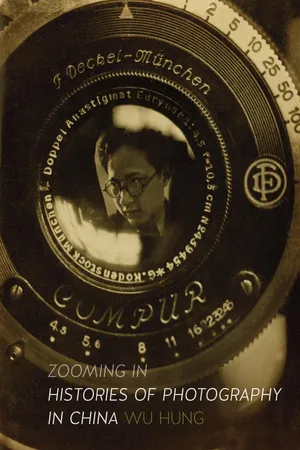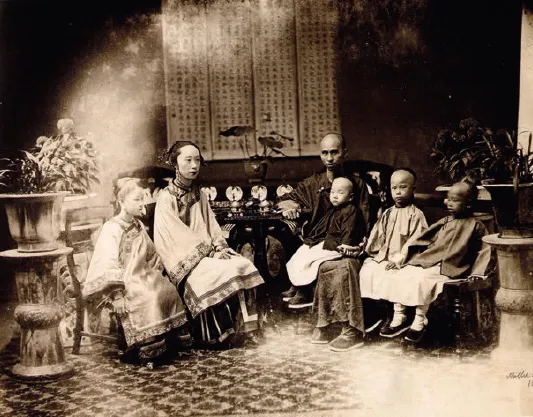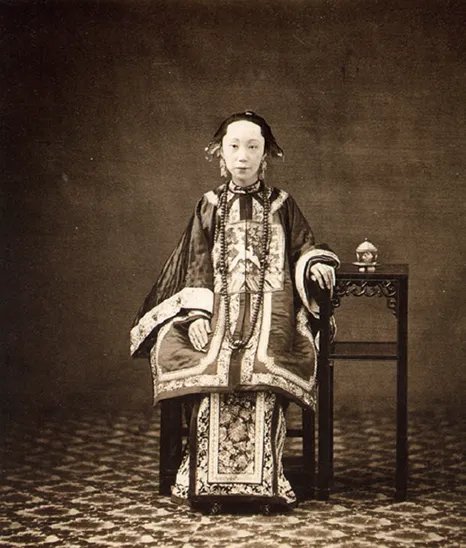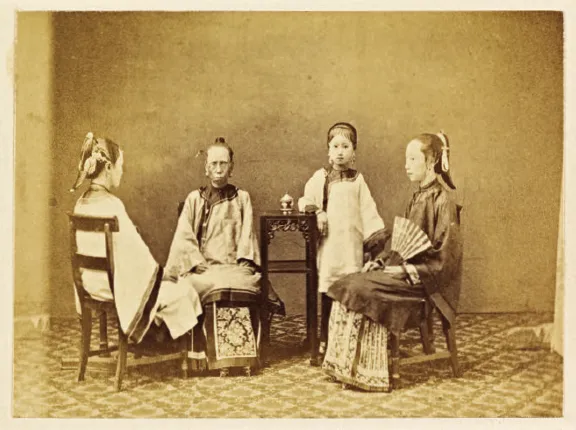![]()
PART ONE REPRESENTING CHINA AND THE SELF
2 Milton Miller, The First Wife of the Tartar General, Canton, 1860–63, albumen silver print.
![]()
1. INVENTING A ‘CHINESE’ PORTRAIT STYLE IN EARLY PHOTOGRAPHY: THE CASE OF MILTON MILLER
Not much can be said about Milton M. Miller’s (1830–1899) professional life.1 Piecing together scattered records, we know that before starting his brief but productive career in China, he worked from 1856 to 1860 as a cameraman in Robert H. Vance’s San Francisco gallery.2 In 1859, Vance (1825–1876) formed a partnership with Charles Leander Weed (1824–1903), an adventurous photographer and entrepreneur who later opened galleries from Nevada and California to the Far East.3 When Weed moved to Hong Kong in 1859, Miller followed, serving as the ‘operating artist’ in the newly established Weed and Howard Photographic Gallery in both Hong Kong and Guangzhou.4 According to an advertisement from 1860, the gallery was equipped with ‘a large Solar Camera by which Photographic Portraits can be taken Life Size; this is a new invention to which the Advertisers would call especial attention’.5 In 1861, Weed left for Shanghai to look for new venues; Miller took over the gallery’s ownership and established the firm of Miller & Co., Photographers.6 It is unclear how long he maintained the Guangzhou operation: in August 1861, Miller announced that the branch would be open for business for only a month. During this period, he also suffered a burglary; the missing properties included ‘the whole of the articles’ in the gallery and a box of negatives.7 It is likely that Miller operated mainly in Hong Kong, from where he travelled to Macao, Guangdong and other locations on commission. For example, in May 1861 he sailed to Nagasaki, Japan, where he made a series of stereoviews for the American publishers E. & H. T. Anthony.8 Another commission came from Dr John Kerr at the Canton (that is, Guangzhou) Hospital; he invited Miller to photograph a Chinese patient whose body and arms were ‘covered with hundreds of tumors’.9 This was the first documented use of photography in China for medical research in an institutional context. Miller terminated his Chinese venture in 1863 and returned to his hometown in Vermont, selling his business and negatives in Hong Kong to his former operator S. W. Halsey.10 It seems that, once resettled in America, he reinvented himself as a real-estate investor and largely abandoned the career of a photographer; the 1870 U.S. census identifies him as a ‘retired photographer’.11
Among the Western photographers working in China from the mid- to late nineteenth century, Miller is best known for his portraits of Chinese officials, businessmen and women. To many collectors and researchers, these are prized artistic images that not only demonstrate the photographer’s technical sophistication but also reveal the sitter’s inner character – a combination rarely seen in the early photography of China.12 Take his portrait of an old woman, for example (illus. 2); she wears an elaborately embroidered robe with matching vest and skirt – the ceremonial garb of a Qing official’s wife. Though expressionless, her wrinkled face shows signs of a long, unhappy life, delicately contrasting with her ornate crown of jewels and flowers. The image is subtle yet direct. Light, which comes from above and focuses on the woman’s body and face, foregrounds her from the shadowed surroundings. The sense of visual immediacy and the woman’s individualized appearance reconfirm the picture’s identity as a portrait13 and explain why this and similar images by Miller have been praised as ‘the most significant body of nineteenth-century Chinese official portraits’.14
But who is this woman? Is she really the wife of a Tartar General, as a version of the picture’s English caption says? Who is this Tartar General? Why did the woman come to Miller’s studio to have a formal visage taken? These questions have never been asked because people have willingly trusted the image to be a genuine portrait, mainly based on its heightened naturalistic effect. But during a workshop on photographs of China in 2006, this image was scrutinized along with some other Miller pictures.15 Certain peculiar features of these photographs were recognized. One problem concerns the old lady’s clothes, which are worn by different women in other Miller pictures, including a young lady whom the caption identifies as the wife of a Cantonese mandarin.
WHO IS THE SITTER?
Taking this initial discovery as a clue, I have tried to trace the links between Miller’s Chinese portraits by comparing their subjects, costumes, settings and props. Many more connections can be established: the young woman is shown both individually and with her husband; the husband is also photographed with his mother and younger brother; the mother, who turns out to be none other than the ‘wife of the Tartar general’, appears with other women in yet another picture. This detective work has finally singled out eleven photographs as belonging to a tight, ‘feature-sharing’ cluster: the same people appear and reappear in these pictures in different costumes and changing groups, and the portraits were all shot in the same place and with an identical photographic style.16 Their iconographical consistency and stylistic coherence suggests a loosely defined ‘project’: it is possible that Miller created these images during his short stay in Guangzhou in 1861. Before contemplating the implications of these findings, however, we need to look more closely at the images.
The most frequently photographed and most photogenic sitter among Miller’s subjects is the young man in four images reproduced here. In A Young Chinese Man, he wears a winter-style official surcoat (bufu); the bird insignia in the square badge on his chest identifies him as a civil official (illus. 3). During the Qing dynasty there were nine degrees of civil officials, whose different ranks were indicated by various bird motifs on their badges. In the present case, the bird is probably the silver pheasant (baixian), the symbol of the fifth-degree civil official. The same man appears with his wife, in full court dress; here he has changed into a summer-style surcoat made of semi-translucent gauze (illus. 4). The bird insignia on the surcoat differs from the first one and indicates a different official rank.17 The same man also appears in two other pictures in casual, domestic clothes. In one, he sits with his wife and their four children (illus. 5); in the other, he is with his aged mother, his younger brother and three children (illus. 6). But it seems that only two children are his: according to traditional customs, the boy sitting next to the younger brother should be the latter’s son.
The young wife portrayed in the second image also reappears in multiple pictures (illus. 7, 8 and possibly 11). Both in the portrait with her husband (illus. 4) and in Mandarin Lady (illus. 7), she wears a full set of the ceremonial attire of an official’s principal wife, including an embroidered robe with official insignia and a matching skirt, a jewelled crown and a long necklace. During the Qing dynasty, a lady put on such a formal costume only on ceremonial occasions. But the woman in Mandarin Lady sits in a languid pose, which seems at odds with her supposed social status and the implied formal occasion. Leaning to one side, she puts an arm on a traditional-style tea table (chaji) while exposing her tiny bound feet.18 A Chinese Woman presents an even bigger problem: here she is dressed in a Han-style unofficial jacket and skirt, but with a rank badge on the chest (illus. 8). Not only is it highly unusual to combine a rank badge with an informal jacket, but the badge also differs from the one in the previous picture. According to Yuhang Li, who has extensively researched traditional Chinese costumes, the badge seems to have been added arbitrarily onto the jacket, because it covers the embroidered borders running from the neckline to the lower hem.19
3 Milton Miller, A Young Chinese Man, 1860–63, albumen silver print. | |
4 Milton Miller, A Mandarin and His Wife in Full Court Dress, 1860–63, albumen silver print.
5 Milton Miller, Chinese Family, 1860–63, albumen silver print.
6 Milton Miller, The Same Mandarin in Civilian Dress, with His Aged Mother Sitting in the Middle, His Brother on the Right Hand, and Three Children, 1860–63, albumen silver print. | |
The young man’s clothes – his winter-style surcoat, fur hat and collar (illus. 3) as well as his summer-style surcoat with a different rank badge (illus. 4) – are shared by a middle-aged man in two further images (illus. 9, 10). In one, this older man is accompanied by his wife (illus. 10). Her clothes are completely identical to those in the two images of the young woman (illus. 4, 7). Like the younger couple, the middle-aged couple is portrayed again with other family members in plain clothes (illus. 12).
Similarly, the young man’s aged mother in the image above reappears in the picture discussed at the beginning of this chapter, in which she has changed her plain robe to ceremonial garb (illus. 2). Upon close comparison, we find that she, the young woman (illus 4, 7) and the middle-aged woman (illus. 10) all wear the same set of clothes and ornaments, including the robe, skirt, vest, crown and necklace. Moreover, her identity as the ‘Wife of the Tartar General, Canton’ cannot be true because in other pictures she and her children all wear typically Chinese clothes. One of these ‘Chinese’ images is shown above. The other photograph is Chinese Ladies of Rank, in which she appears with other female figures to represent three generations of women in a family (illus. 11).
These eleven pictures were all shot in the same space, as indicated by the identical diamond patterns on the carpet and the same plain backdrop. They also employ identical props, including two side tables (one Chinese style and the other Western style), a set of covered teacups and two sets of chairs. In two cases, additional props such as potted flowers, calligraphy scrolls and a table screen are employed to generate a stronger domestic atmosphere (illus. 4, 5). This space is clearly Miller’s studio in Guangzhou.20
7 Milton Miller, Mandarin Lady, 1860–63, albumen silver print.
8 Milton Miller, A Chinese Woman, 1860–63, albumen silver print.
9 Milton Miller, A Chinese Man, 1860–63, albumen silver print.
10 Milton Miller, A Mandarin and His Wife in Full Court Dress, 1860–63, albumen silver print.
11 Milton Miller, Chinese Ladies of Rank, 1860–63, albumen silver print.
12 Milton Miller, A Chinese Family, 1860–63, albumen silver print. | |
§
WHY SHOULD WE CONDUCT a close reading that primarily focuses on the sitters’ clothes, ornaments and rank badges? This is because a careful examination of these details – indicators of the sitters’ (supposed) identities – marks the beginning of a serious inquiry into the nature of these historical photographs. Any historical inquiry requires an evidential basis. Due to the paucity of archival evidence in studying early photographic portraits in China,21 this basis can be established only through a systematic inventory and analysis of the intrinsic properties of actual photographs. Such a preliminary examination is both deconstructive and constructive because it simultaneously frees a ...











